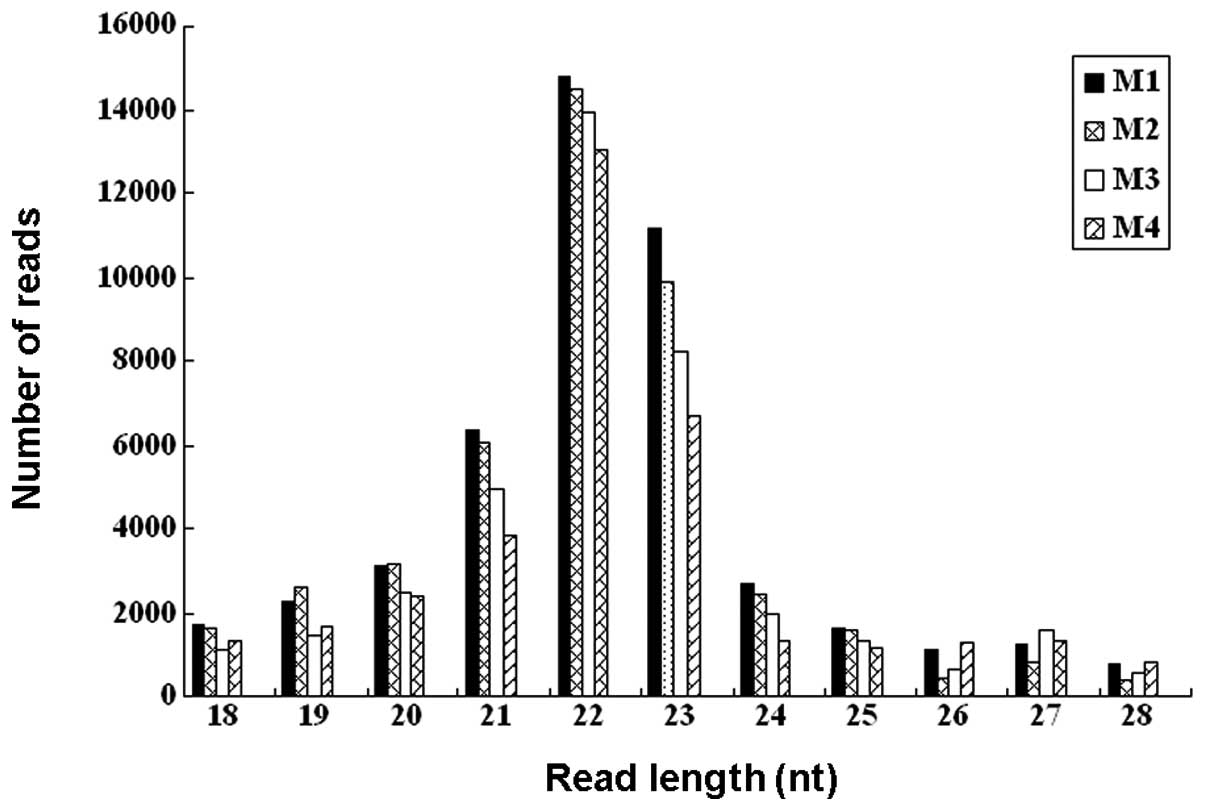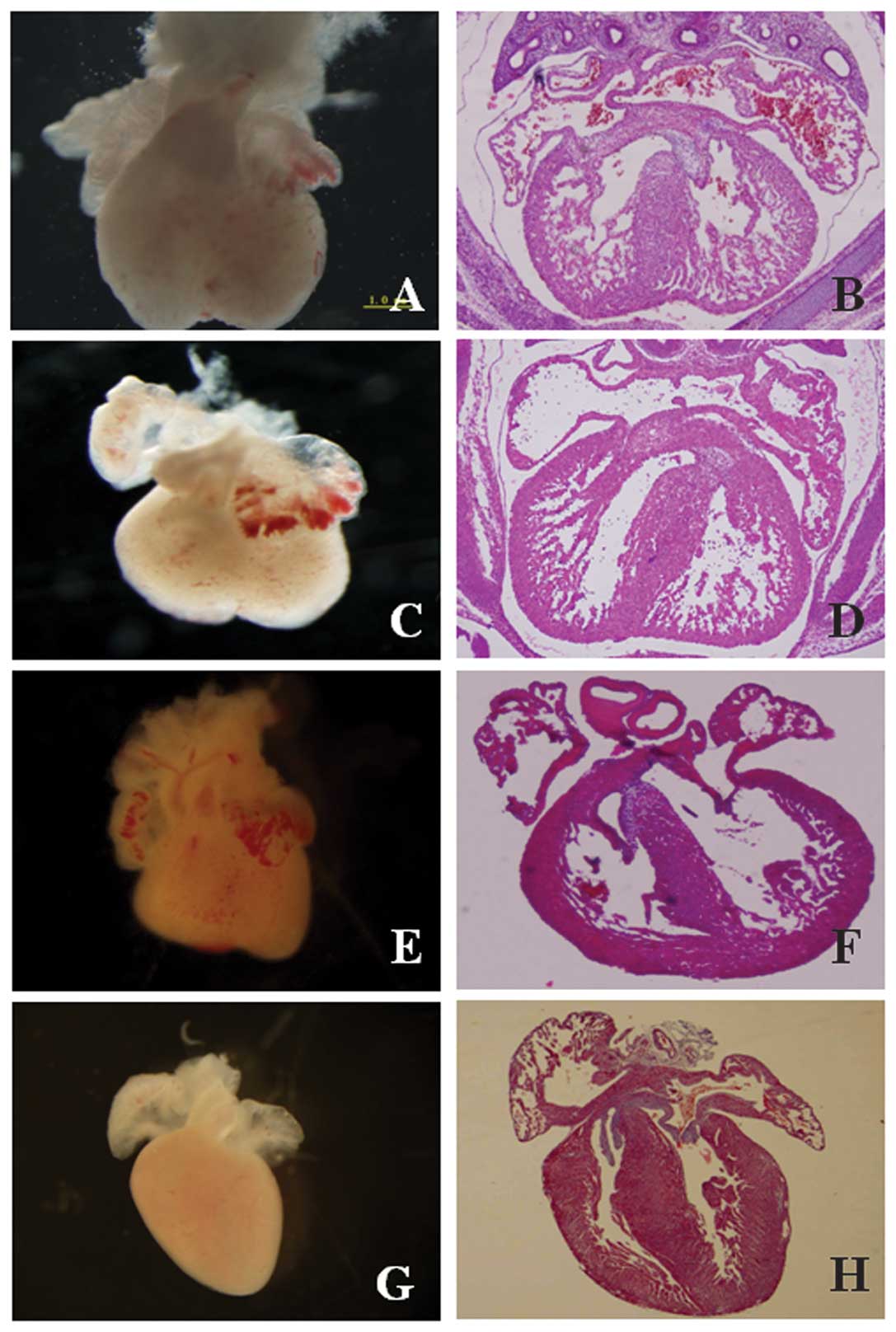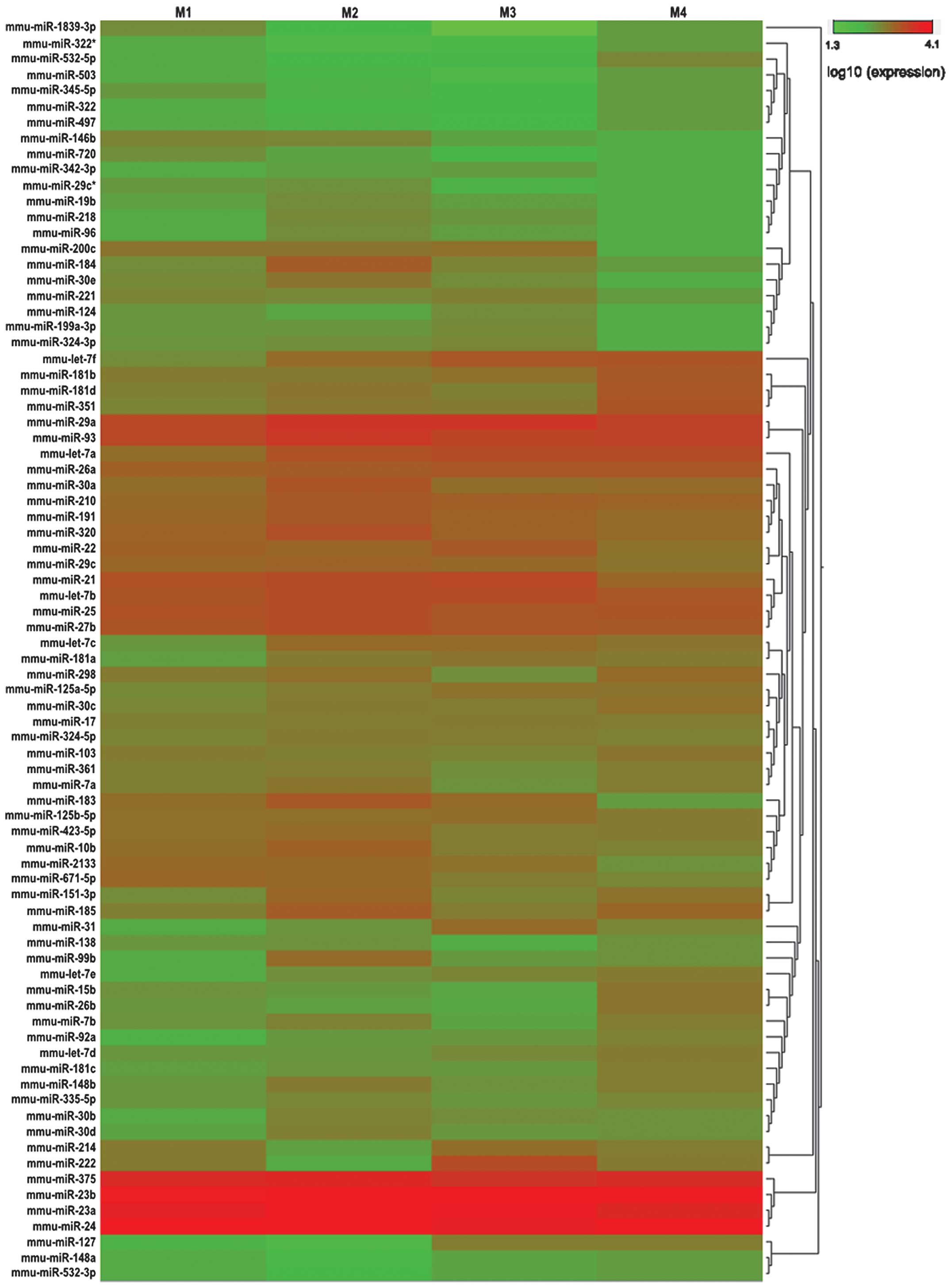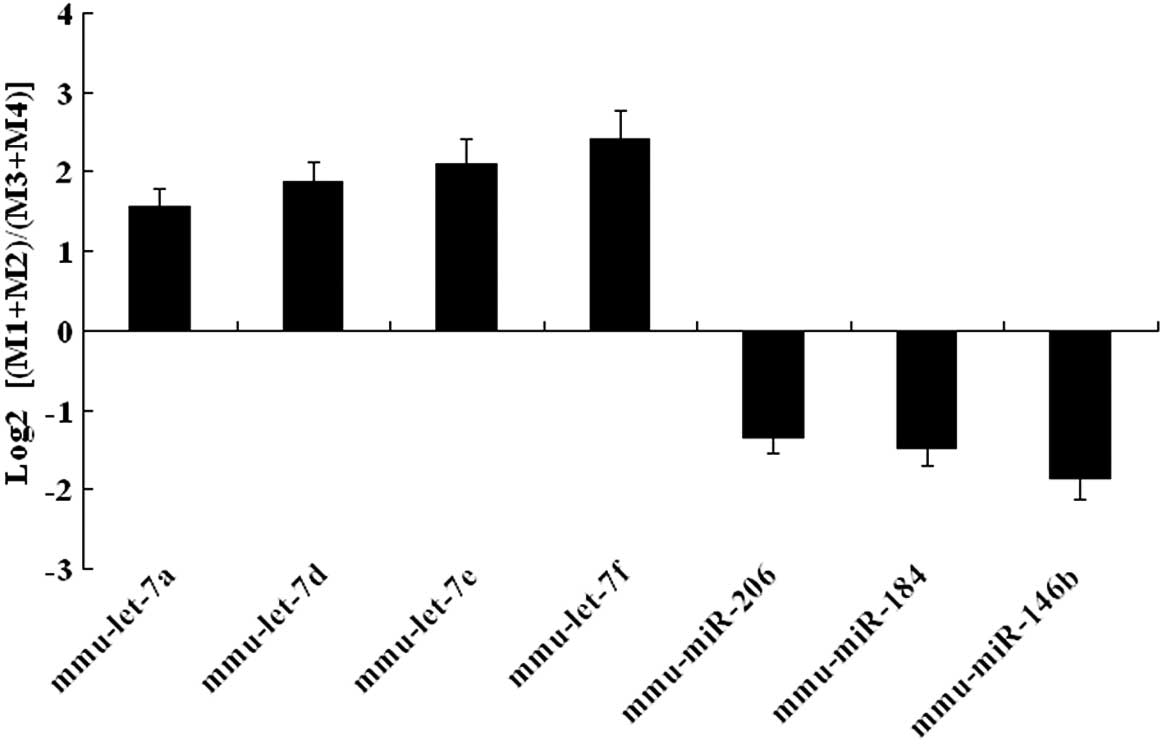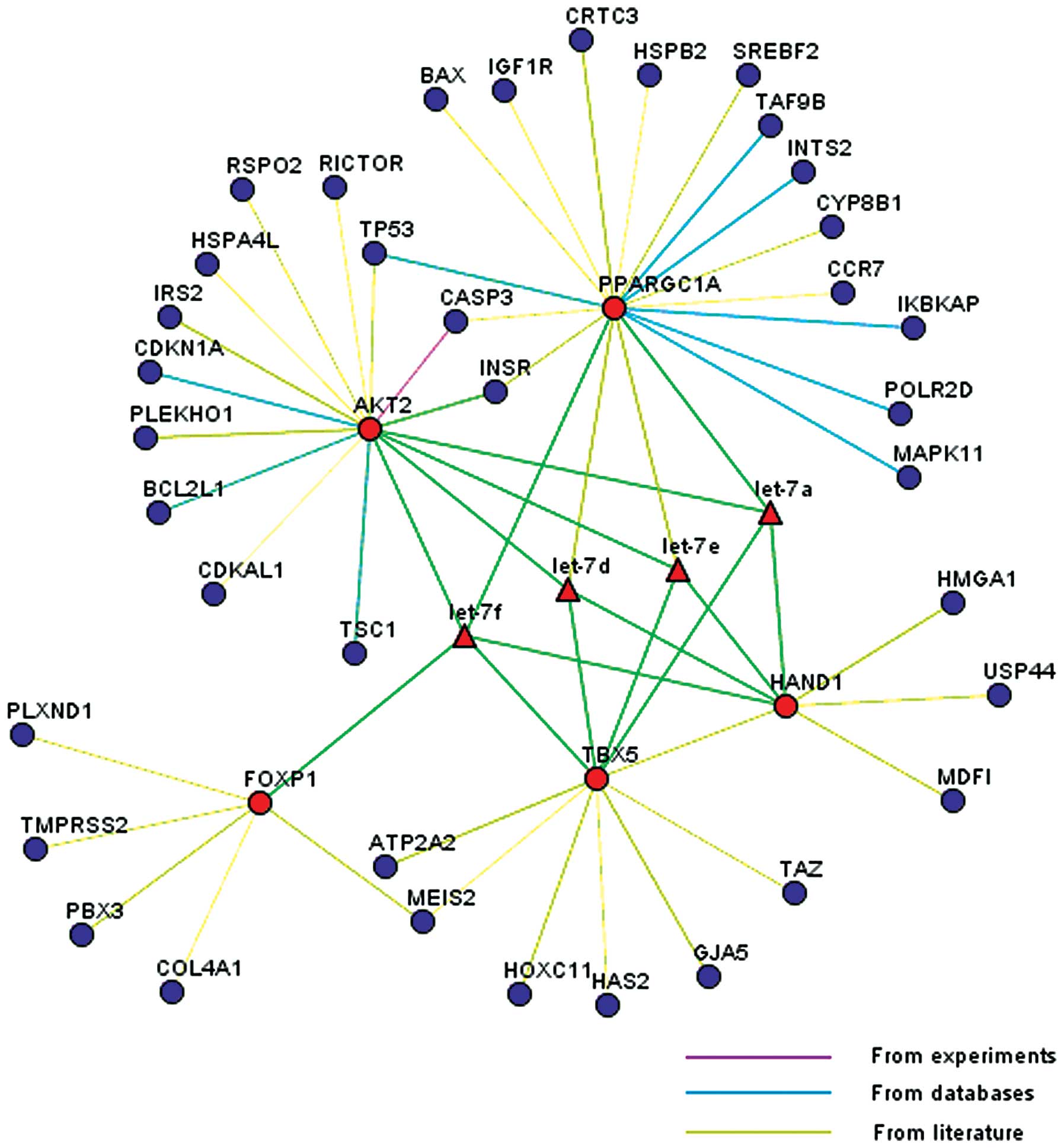microRNA expression profiling of the developing mouse heart
- Authors:
- Published online on: August 9, 2012 https://doi.org/10.3892/ijmm.2012.1092
- Pages: 1095-1104
Abstract
Introduction
microRNAs (miRNAs) are a class of RNA molecules, typically 19–25 nucleotides (nt) long, comprising highly conserved families of non-coding RNA that have gained recognition as important regulators of diverse cell processes, such as proliferation, differentiation, development, and cell death (1). miRNAs are negative regulators of gene expression that inhibit the translation or promote the degradation of target mRNAs, with an estimated 30% of transcribed mRNAs thought to be susceptible to miRNA-mediated regulation (2).
miRNAs play an important role in regulating normal organ physiology and development (3). The elucidation of the spatial and temporal patterns of their expression is important for understanding the precise role of miRNAs in organogenesis (4). To gain a more complete understanding of miRNA functions, investigations were conducted into global patterns of miRNA expression in mammalian tissues, and a number of miRNAs enriched in specific tissues were identified (5). Although the spatial and temporal expression patterns of some developing mouse tissues, such as, retina, bladder and brain, have been analyzed, those of the heart remain to be investiagated (6–8). Through this process, specific miRNAs at critical stages of organ development have been identified and quantified, providing valuable insight into their role during organogenesis.
Findings of previous studies suggested that miRNAs play an essential role in the maintenance of cardiac development and disease (9). A series of studies, profiling miRNA expression in rodent and human hearts under various pathological conditions, including cardiac hypertrophy, heart failure and myocardial infarction demonstrated that miRNAs are involved in cardiac pathophysiology (10–12). The global patterns of miRNA expression of normal human and mouse heart have been profiled in adults (3). Furthermore, some cardiac-specific miRNAs, including miR-1, miR-133a and miR-208a, involved in maintaining cardiac development and function have been identified (13–15).
However, the heart, more than any other organ, has to maintain a high level of function throughout the lifespan of the organism, starting from the early primitive heart tube, to formation of the heart chambers, and throughout life (16). It is known that many miRNAs show spatially and/or temporally restricted expression patterns (17). Thus, by characterizing the spatial and temporal expression profiles of miRNAs in the developing heart, we can improve our understanding of heart development and gene regulation. The differentially expressed miRNAs of mouse ventricular chambers in 3 distinct developmental stages [embryonic day (E)12.5, E15.5 and E18.5] have been profiled (18). Most of the differentially expressed miRNAs exhibited a relatively discrete peak of expression at ventricular developmental stages; however, spatial and temporal expression profiles of miRNAs in heart have not been examined in detail.
The mouse heart shows great similarity to the human heart, with respect to anatomy, growth and development, making the mouse an important experimental model for biomedical research (19). The heart is the first functional organ during mouse embryonic development. During this stage, the primitive heart tube, in which the heart begins to beat at approximately the E9.0, begins to form. The form of the heart starts to take shape at approximately E10.0, and at E12.5–18.5, the tube undergoes a complex series of movements and tissue remodeling events that lead to the formation of the 4-chambered heart (20). Based on this developmental timeline, we selected 4 key time-points (E12.5, E14.5, E16.5 and E18.5) representing the process of normal heart development, to perform a miRNA screening by next-generation sequencing in C57BL/6 mice. The aim of this study was to explore the mechanisms of miRNAs in embryonic heart development, and offer a foundation for future functional analyses.
Materials and methods
Experimental animals
The Nanjing Medical University Animal Care and Use Committee approved the experimental protocols used in this study. Pathogen-free male and female C57BL/6J mice were obtained from the animal center of the Nanjing Medical University. The animals were housed in individual cases in a temperature-controlled room with a 12-h light/dark cycle. At the age of 6 months, the males and females were mated. Pregnancy was detected by visual inspection of a distended abdomen. At E12.5, E14.5, E16.5 and E18.5, pregnant mice were sacrificed with CO2, embryos were collected and fetal hearts dissected and pooled within each age group for further analysis. The 4 experimental groups were designated as: M1 (E18.5), M2 (E16.5), M3 (E14.5) and M4 (E12.5).
Hematoxylin and eosin (H&E) staining
Collected fetal hearts were washed with cold PBS and then fixed in formalin overnight at 4°C. Sections (7 μm) of paraformaldehyde-fixed heart tissue were obtained and stained with H&E for morphological analysis. H&E sections were viewed under a light microscope at magnifications of ×40 to observe changes in fetal heart development at the 4 experimental time-points.
Isolation of miRNA, and sequencing by oligonucleotide ligation and detection (SOLiD) sequencing and analysis
At each time point, fetal cardiac tissue was removed, snap-frozen in liquid nitrogen and stored at −80°C for later analysis. Total miRNA was extracted from cardiac tissue of fetal mice using the mirVana miRNA Isolation kit (Applied Biosystems-Life Technologies Co., Grand Island, NY, USA) according to the manufacturer’s instructions.
The methodological details of sample processing, RNA extraction, library construction, and SOLiD sequencing were described in our previous study (21). Samples of miRNA (100 ng) isolated from cardiac tissue of fetal mouse were processed into sequencing libraries using the Small RNA Expression kit (Applied Biosystems). Briefly, RNA was ligated overnight with the adapters from the kit, reverse-transcribed, RNAse H-treated and PCR amplified before agarose gel electrophoresis for size selection of miRNAs containing inserted sequences of 16–61 nt. Libraries were amplified onto beads using emulsion PCR, deposited on slides and sequenced using the SOLiD v2 sequencing system (Applied Biosystems) at the State Key Laboratory of Bioelectronics, Southeast University, China. Data were analyzed with the SOLiD System Small RNA Analysis Pipeline Tool (RNA2MAP). Acceptable sequences were compared with sequences in the mouse miRBase database (release 14.0, http://www.mirbase.org; Sanger). The threshold for selection was set conservatively to include beads sampled a minimum of 10 times in any of the libraries.
Quantitative real-time PCR
The methodological details of quantitative real-time PCR (qRT-PCR) were described in our previous study (21), which was performed to confirm the differential expression of miRNAs identified by SOLiD sequencing. Briefly, total RNA was isolated from cardiac tissue of fetal mice using TRIzol reagent (Invitrogen, Carlsbad, CA, USA). Single-strand cDNA was synthesized as follows: the reverse transcription mixture contained 2 μl total RNA, 1 μl mmu-miRNA reverse primer (Table I), 1 μl ReverTra Ace, 4 μl 5X buffer, 2 μl dNTP mix (10 mM), 1 μl RNasin, 1 μl random primer and 8 μl RNase-Free H2O (20 μl total volume). The reaction was performed according to the manufacturer’s instructions using the Applied Biosystems 7300 real-time PCR system (Applied Biosystems) (Table II). Data were analyzed using an iCycler™ iQ Optical System Software, Version 3.0a (Bio-Rad Laboratories, Hercules, CA, USA). The relative level of mmu-miRNA was calculated relative to U6 RNA (internal control) using the 2−ΔΔCt method.
Target gene ontology and network analysis of target gene-miRNAs
The methodological details of target gene ontology and network analysis of target gene-miRNAs were described in our previous study (21). In brief, target genes were analyzed by gene ontology (http://www.babelomics.bioinfo.cipf.es/). A graphical representation of the network between the miRNAs and their predicted targets involved in cardiac development was identified by IPA analysis (http://www.ingenuity.com/).
Statistical analysis
Putative miRNA candidates were selected according to the following criteria: i) at least 10 copies by SOLiD sequencing; ii) fold-change >2, based on the normalized counts between different time-points (M1 vs. M2, M1 vs. M3, M1 vs. M4, M2 vs. M3, M2 vs. M4 and M3 vs. M4), as well as between the later development group (M1+M2) and early development group (M3+M4); iii) the data of the qRT-PCR were presented as the mean ± SEM. P<0.05 was considered statistically significant.
Results
Overview of the SOLiD sequencing data
After SOLiD sequencing, raw reads were obtained from the small RNA library. Low-quality reads were removed, and the 39 adaptor sequences were trimmed. Small RNA sequences ranging in size from 18 to 28 nt were retrieved from the raw data set. The size distributions of the reads are shown in Fig. 1. The majority of the small RNAs were between 21 and 23 nt in size. Sequences of 22 nt accounted for 31.5–37.3% of total sequence reads in the 4 samples, which is the typical size range for Dicer-derived products. The 23 nt size class was also dominant.
Histology
A series of hearts were collected at each time point for histological analysis using H&E (Fig. 2). The typical features of the developing heart were observed at each time point: in the M4 group, the endocardial cushions appeared to fuse, and the sepals, aorta and tracheal were also visible. In the M3 group, aortic and pulmonary arterial structures were found to be well-developed, and the left ventricular outflow tract, the inflow tract and mitral valve were all visible. In the M2 group, the myocardium had completed development. In the M1 group, the endocardial, myocardial and epicardial layers had matured.
miRNA expression profile
The expression profiles of miRNAs in the cardiac tissue of fetal mice were analyzed in 4 samples. The top expressed miRNAs of the 4 groups are shown in Table III, including miRNAs present at >1% of total read counts. The types of the top expressed miRNAs gradually increased along with the increasing gestational age from E12.5 to E18.5. The 10 miRNAs included in the top expressed miRNAs of the 4 groups are: mmu-miR-23b, mmu-miR-24, mmu-miR-23a, mmu-miR-375, mmu-miR-29a, mmu-miR-93, mmu-miR-21, mmu-miR-25, mmu-let-7b and mmu-miR-27b.
We used a threshold of at least 10 copies by SOLiD sequencing in the 4 groups, and found 80 miRNAs that met those requirements. These miRNAs were used for further hierarchical cluster analysis (Fig. 3). As a result, 77 differentially expressed miRNAs in the 4 groups (M1, M2, M3 and M4) passed our fold-change filter (fold-change >2.0), including 51 differentially upregulated miRNAs and 26 differentially downregulated miRNAs (Tables IV and V). Among the differentially expressed miRNAs, we identified 8 downregulated and 6 upregulated miRNAs in M1/M2; 2 downregulated and 8 upregulated miRNAs in M1/M3; 5 downregulated and 7 upregulated miRNAs in M1/M4; 3 downregulated and 13 upregulated miRNAs in M2/M3; 3 downregulated and 13 upregulated miRNAs in M2/M4; 5 downregulated and 4 upregulated miRNAs in M3/M4, all with a fold-change >2 (Tables IV and V). From this list of differentially expressed miRNAs, we aimed to identify miRNAs that were consistently downregulated or upregulated during heart development, however, no miRNA met these requirements.
Since there was no miRNA showing obvious fold-changes consistently between the 4 groups, we re-analyzed our data to profile the differentially expressed miRNAs between the later development group (M1+M2) and the early development group (M3+M4). Using this analysis 16 differentially expressed miRNAs located in 11 chromosomes were identified (Table VI), 3 of which were downregulated and 13 of which were upregulated, with a fold-change >2.
Table VI.Differentially expressed miRNAs of the fetal mouse heart the between late development and early development groups. |
Validation of differentially expressed miRNAs
SOLiD sequencing results were validated by qRT-PCR expression analysis in the later development and early development groups. Upregulated miRNAs (mmu-let-7a, mmu-let-7d, mmu-let-7e and mmu-let-7f) and downregulated miRNAs (mmu-miR-206, mmu-miR-184 and mmu-miR-146b) were selected for additional analysis. This confirmatory process showed that our expression data obtained by qRT-PCR analysis were comparable with the sequencing data (Fig. 4).
Target gene ontology and target gene-miRNA network analysis
Of the miRNAs identified for additional analysis, a subset (mmu-let-7a, mmu-let-7d, mmu-let-7e and mmu-let-7f) was found to be from the same polycistronic miRNA cluster (let-7), and were upregulated when comparing the later development group with the early development group. Predicted targets of the 4 differentially expressed miRNAs of the let-7 cluster were grouped into different categories. The top 13 gene ontology (GO) terms are shown in Table VII. The majority of targets were classified according to developmental processes, cell organization and biogenesis, thus reflecting the profound biological changes occurring in the developing mouse heart. A network relationship between the predicted targets of the 4 differentially expressed miRNAs of the let-7 cluster and these miRNAs was analyzed. Five candidate genes (FOXP1, TBX5, HAND1, AKT2 and PPARGC1A), known to be involved in cardiac development were profiled. These five genes were located in the center of the network, whereas the remaining 37 genes, which were associated with the 5 candidate genes, were located on the edge of the network (Fig. 5).
Discussion
In the present study, we have characterized the miRNA expression profile in the developing mouse heart from E12.5 to E18.5 using next-generation sequencing. Currently, the most well-studied miRNAs are generally those that are expressed at the highest levels in tissues (22). The 10 top expressed miRNAs identified in the developing heart in the M1, M2, M3 and M4 groups are: mmu-miR-23b, mmu-miR-24, mmu-miR-23a, mmu-miR-375, mmu-miR-29a, mmu-miR-93, mmu-miR-21, mmu-miR-25, mmu-let-7b and mmu-miR-27b. This dataset has some overlap with previously published data on miRNA expression in the adult mouse heart (23–25); specifically, there are 3 miRNAs (mmu-miR-27b, mmu-miR-23a and mmu-miR-24) which appear to be highly abundant in both embryonic and adult hearts (Table VIII). These miRNAs have previously been investigated to assess their function in the heart, including the creation of cardiac-specific miRNA transgenic mice. For example, transgenic mice with cardiomyocyte-specific over-expression of miR-27b are able to induce cardiac hypertrophy and dysfunction (26), miR-23a transgenic mice also exhibit exaggerated cardiac hypertrophy (27), and transgenic mice with cardiac overexpression of miR-24 results in embryonic lethality (28). Given the insightful phenotypes observed in these mice, other miRNAs abundant in the developing heart should be investigated to gain a better understanding of the regulatory mechanisms of cardiac development.
Although some of the miRNAs identified as being highly abundant in the developing heart (i.e., mmu-miR-21, mmu-miR-25, mmu-miR-93 and mmu-miR-375) in this study, were not the top expressed miRNAs of the adult mouse heart (Table VIII), some of these miRNAs have previously been associated with heart function. For example, mmu-miR-21 is known as a differentiation-state-related miRNA (29), and as a cardiac muscle marker. Overexpression of miR-21 in a transgenic mouse heart resulted in suppression of the ischemia-induced upregulation of PTEN and FasL expression, a smaller infarct size, and ameliorated heart failure (30). Mmu-miR-25 and mmu-miR-93, both of which are in the miR-106b-25 cluster, also seem to have some significance for heart function. Transfection of miR-25 is sufficient to decrease the collagen gene expression in isolated cardiac fibroblasts in vitro (31), and miR-93 is downregulated during cardiac hypertrophy (32). It has also been postulated that miR-375 is a potential biomarker of acute ST-segment elevation myocardial infarction (33).
A third group of miRNAs to be considered are those that were highly abundant in the adult mouse heart (i.e., mmu-miR-1, mmu-miR-126 and mmu-miR-133a) (Table VIII), but were not in the top expressed miRNAs of the present study. Previous studies have shown that both miR-1 and miR-133 are important in the remodeling of the heart that occurs during cardiogenesis (34), and miR-126 has been shown to be sufficient to regulate vascular integrity and angiogenesis (35).
miRNAs may be expressed preferably during particular developmental time-points, or within certain tissues. Moreover, within a developmental framework, miRNAs may exhibit dynamic expression patterns (36). A major focus of our study was to define the repertoire of miRNAs expressed at different time-points of heart development. In terms of broad classes with expression that changed during development, two major expression profiles were identified: miRNAs expressed predominantly early in heart development and those expressed predominantly in the mature and developed heart. Our comparative clustering analyses have shown that there is 1 upregulated miRNA (mmu-miR-185) and 1 downregulated miRNA (mmu-miR-103) when we compared M1, M2, M3 and M4 (E12.5, early in heart development), respectively. This showed that the 2 highly conserved miRNA expression patterns at this point of heart development may be important, but no mechanistic studies investigating the relationship between these 2 miRNAs and heart development and function are currently available.
There are 3 upregulated miRNAs (mmu-miR-221, mmumiR-222, and mmu-miR-22) and 1 downregulated miRNA (mmu-miR-26b) differentially expressed when we compare M1 (E18.5, mature and developed heart) and M2, M3, M4, respectively. This showed that the 4 highly conserved miRNA expression patterns at this point of development may be important in heart and vascular development. miR-221 and miR-222 are known to be novel regulators for vascular smooth muscle cell proliferation (37), while miR-22-deficient mice show evidence of cardiac decompensation and left ventricular dilation (38). Overexpression of miR-26b in the heart was shown to inhibit upregulation of its targets and the development of hypertrophy (39).
For comparative analysis, we also profiled the differentially expressed microRNAs between the 4 different experimental time-points. Hierarchical cluster analysis showed a number of miRNAs that were differentially expressed during the investigated time frame of development, although no miRNAs were consistently downregulated or upregulated in the different groups. As such, we profiled the differentially expressed miRNAs between the later development (M1+M2) and early development (M3+M4) groups, and 3 downregulated and 13 upregulated miRNAs were identified. From this group of 16 differentially expressed miRNAs, let-7a/7d/7e/7f were all upregulated miRNAs that are known to be abundantly expressed in adult mouse heart tissue (24). Predicted targets of let-7a/7d/7e/7f are associated with developmental processes, cell organization and biogenesis, indicating profound biological changes occurring in the developing mouse heart. A network analysis of the predicted targets of let-7a/7d/7e/7f has shown that 5 target genes (FOXP1, TBX5, HAND1, AKT2 and PPARGC1A) are known to be involved in cardiac development (40). It is also known that these miRNAs, which are involved in mouse embryonic hearts, are able to regulate the expression of the 5 target genes by binding to a highly conserved target site in their 3′UTR.
In conclusion, our experiments identified a series of miRNAs abundantly expressed in the developing heart, as well as several differentially expressed miRNAs between late and early heart development. We believe that these miRNAs likely play an important role in heart development, thus additional studies may clarify the mechanism(s) of normal heart development, and provide a physiological basis for future investigations on congenital heart disease.
Acknowledgements
This study was supported by grants from the National Natural Science Foundation of China (Grant no. 81070500), the Key Medical Personnel Foundation of Jiangsu Province (Grant no. RC2011021), the Nanjing Medical Science and Technique Development Foundation, and the Science and Technology Development Foundation of Nanjing Medical University (Grant no. 2010NJMUZ15).



